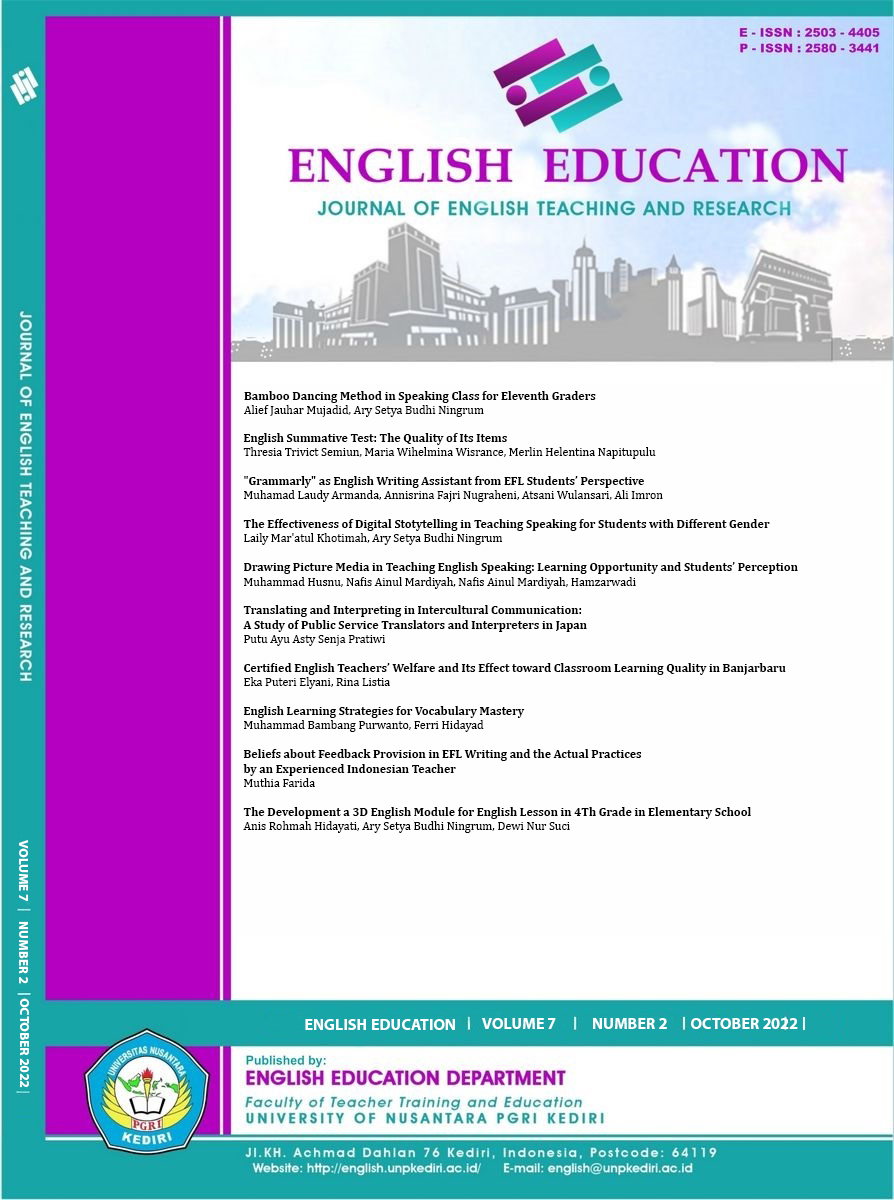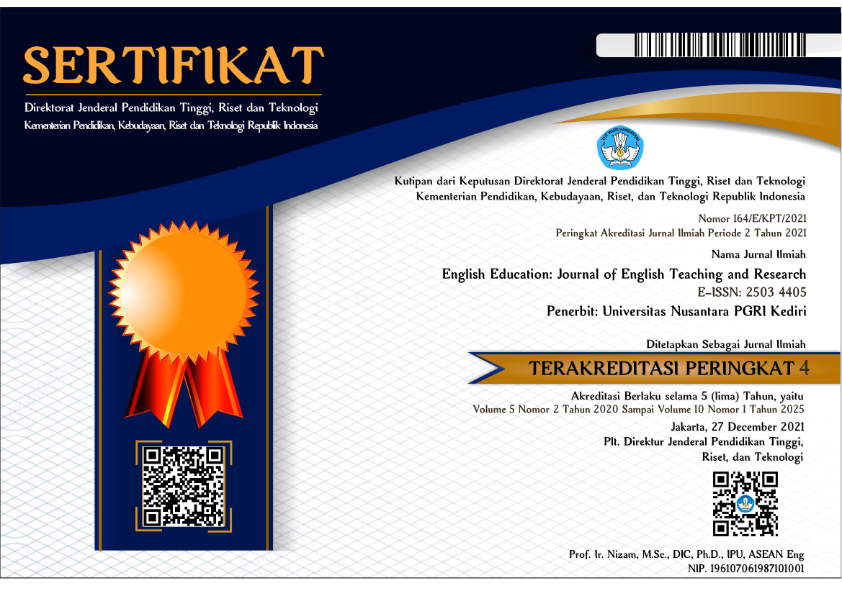The Effectiveness of Digital Stotytelling in Teaching Speaking for Students with Different Gender Classification
DOI:
https://doi.org/10.29407/jetar.v7i2.18272Keywords:
Digital Storytelling, Teaching Speaking, Gender, digital storytelling, teaching speaking, genderAbstract
The purpose of this study is to find out the effectiveness of using digital storytelling towards students’ speaking ability based on gender classification. The samples of this study were two classes of class IX students from MTsN 1 Kediri. The experimental group was Class IX-G, and the control group was Class IX-I. Both pretest and posttest set were used as the research instrument. To determine the effectiveness of the media utilized, ANCOVA analysis was used, and an independent sample T-test was used to determine gender differences. The study's findings revealed the effectiveness of digital storytelling to teach speaking as evidenced by sig.=.0000<.05. Further analysis proceeded to the effectiveness of digital story telling based on gender classification. As evidenced by sig. =.003.05., digital story telling was effective in teaching speaking to female students. Meanwhile, male students were not empowered. By sig=.416 >.05., there was no statistically significant difference between male students taught using digital storytelling and those taught using printed text evidence. It means that both teaching media are equally effective for teaching speaking to male students.
Downloads
References
Abdullah, A. N., & Yunus, M. M. (2019). Students’ Reading Motivation across Gender and the Teachers’ Perception in Malaysian Primary Classroom. Modern Journal of Language Teaching Methods, 9(4).
Alcantud-Diaz, M., Vayá, A. R., & Gregori-Signes, C. (2014). ‘Share your experience’. Digital storytelling in English for tourism. Ibérica, Revista de la Asociación Europea de Lenguas para Fines Específicos, (27), 185-204.
Anggaraeny, E. D. (2015). The use of animated video to teach writing narrative text. Retain, 3(1).
binti Hamidon, N. A. (2015). Study on students learning style according to gender factor. J. Cult. Soc. Dev., 8, 20-22.
Budiasih, N. N. (2017). Learning Styles Preferences of Esl Students at Sma Negeri Bali Mandara (SAMPOERNA ACADEMY). Prasi: Jurnal Bahasa, Seni, dan Pengajarannya, 8(16).
Chen, X., Yuan, H., Zheng, T., Chang, Y., & Luo, Y. (2018). Females are more sensitive to opponent’s emotional feedback: evidence from event-related potentials. Frontiers in Human Neuroscience, 12, 275.
Frazel, M. (2010) Digital storytelling guide for educators. Washington, D.C.: International Society for Technology in Education.
Hamalik, O. (1994). Media Pendidikan, cetakan ke-7. Bandung: Penerbit PT. Citra Aditya Bakti.
Heriyana, W.(2014) “Penerapan Metode Digital Storytelling Pada Keterampilan Menceritakan Tokoh Idola Mata Pelajaran Bahasa Indonesia Siswa Kelas VII di SMP Negeri 1 Kedamean, Gresik.”Jurnal Mahasiswa Teknologi Pendidikan5, no.2.
Idayani, A. (2019). The Effectiveness of Digital Storytelling on Students’ Speaking Ability. Lectura: Jurnal Pendidikan, 10(1), 33-46.
Loertscher, D. (2009). Content Area Reading, Writing, and Storytelling: a Dynamic Tool for Improving Reading and Writing Across the Curriculum Through Oral Language Development. Teacher Librarian, 36(4), 60-61.
Mohamed Salama Eissa, H. (2019). Pedagogic effectiveness of digital storytelling in improving speaking skills of Saudi EFL learners. Arab World English Journal (AWEJ) Volume, 10.
Muhyadi, et al. (2010) “Pelatihan Pembuatan Media Digital Story Telling (DST) Dalam Rangka Pengembangan Media Berbasis ICT untuk Pembelajaran Kelas SBI di SMP 1 Karangmojo.” File .doc. Pengabdian kepada Masyarakat Prioritas Fakultas. Universitas Negeri Yogyakarta.
Poynton, C. (1985). Language and gender: Making the difference. Geelong. Victoria: Deakin University Press.
Rahayu, S. (2016) “The Comparison Between Male and Female Students’speaking Ability”. Eltin Journal: Journal of English Language Teaching in Indonesia4, no. 2 : 21-32.
Ratnawati, S. R., Yuliasri, I., & Hartono, R. (2018). Enhancing the Students’ Speaking Skill Using Three Step Interview and Numbered Heads Together. Language Circle: Journal of Language and Literature, 12(2), 173-181.
Shuib, M., & Azizan, S. N. (2015). Learning Style Preferences among Male and Female ESL Students in Universiti-Sains Malaysia. Journal of Educators Online, 12(2), 103-141.
Sinaga, P. D., Sari, A. S. P., & Sembiring, N. (2021). The Use of Digital Storytelling to Enhance the Speaking Skill of the Eleventh Grade Students of Sma Swasta Palapa Medan in the Academic Year of 2020/2021. KAIROS, 5(1).
Syahrir, S. (2019). Male and Female Students’ Learning Styles and Their Effects on Efl Achievements (Doctoral dissertation, UNIVERSITAS NEGERI MAKASSAR).
Yule, G. (1989). The spoken language. Annual Review of Applied Linguistics, 10, 163-172.
Zhang, S. (2009). The Role of Input, Interaction and Output in the Development of Oral Fluency. English language teaching, 2(4), 91-100.
Zuana, M. (2018) “Digital Storytelling: An Attractive Media to Teach Narrative Text in Speaking Class.” Alsuna: Journal of Arabic and English Language 1, no. 1 : 27-39.
Downloads
Published
Issue
Section
License
Authors who publish with this journal agree to the following terms:
- Copyright on any article is retained by the author(s).
- The author grants the journal, the right of first publication with the work simultaneously licensed under a Creative Commons Attribution License that allows others to share the work with an acknowledgment of the work’s authorship and initial publication in this journal.
- Authors are able to enter into separate, additional contractual arrangements for the non-exclusive distribution of the journal’s published version of the work (e.g., post it to an institutional repository or publish it in a book), with an acknowledgment of its initial publication in this journal.
- Authors are permitted and encouraged to post their work online (e.g., in institutional repositories or on their website) prior to and during the submission process, as it can lead to productive exchanges, as well as earlier and greater citation of published work.
- The article and any associated published material is distributed under the Creative Commons Attribution-ShareAlike 4.0 International License








 Article template
Article template



